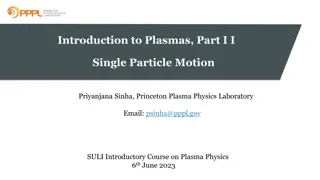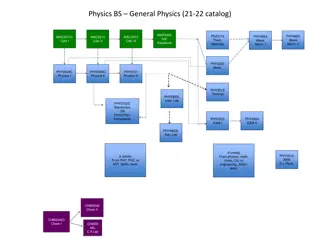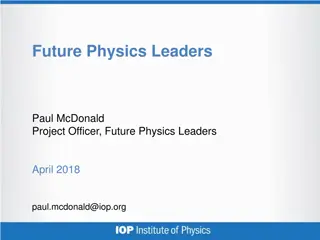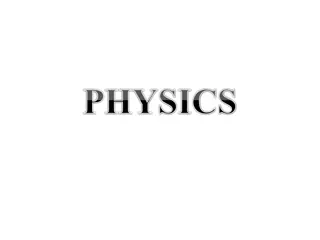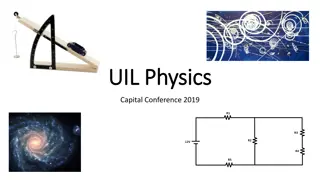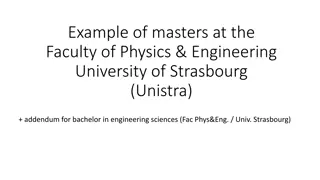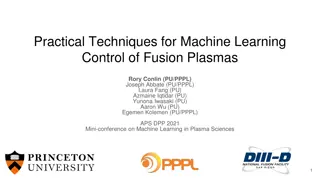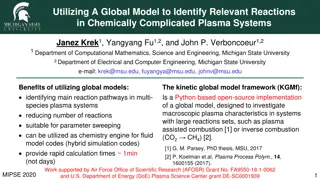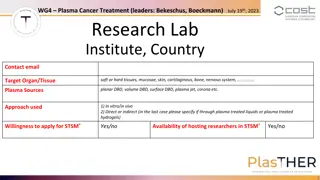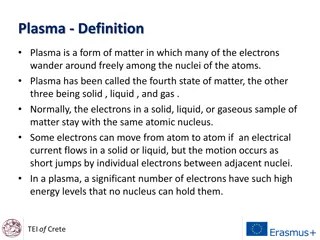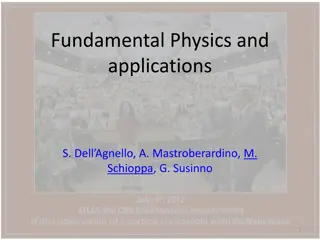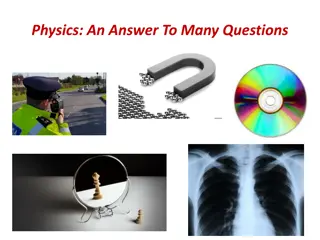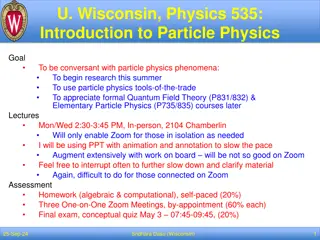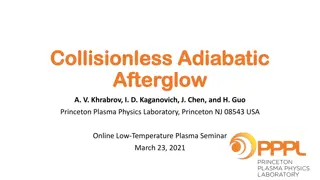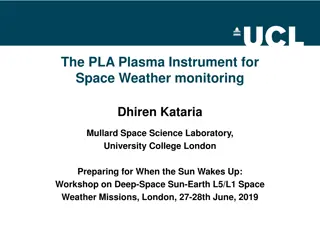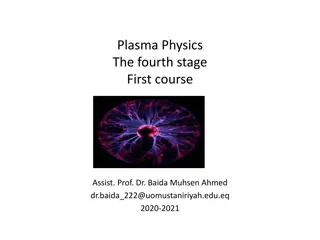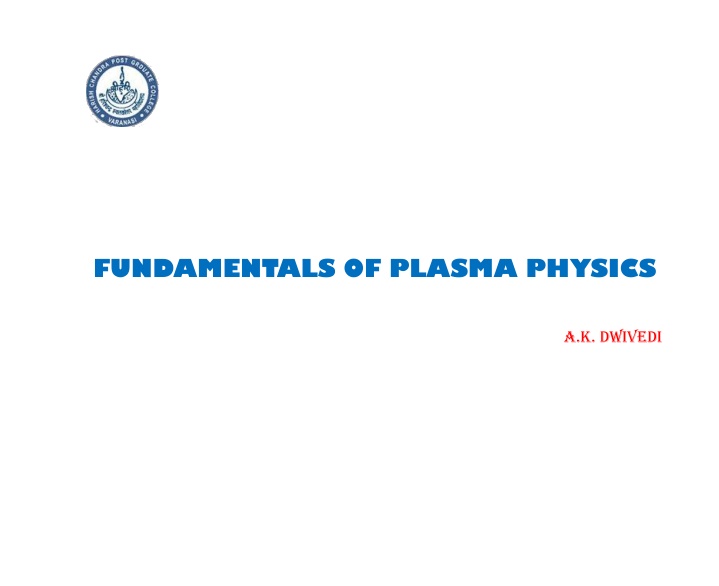
Plasma Physics Fundamentals and Occurrence in Nature
Explore the fundamentals of plasma physics, including its occurrence in nature where it comprises a significant portion of the universe. Learn about the transition from neutral gas to plasma state, the Saha equation, and the defining characteristics of plasma such as collective behavior and Debye shielding.
Download Presentation

Please find below an Image/Link to download the presentation.
The content on the website is provided AS IS for your information and personal use only. It may not be sold, licensed, or shared on other websites without obtaining consent from the author. If you encounter any issues during the download, it is possible that the publisher has removed the file from their server.
You are allowed to download the files provided on this website for personal or commercial use, subject to the condition that they are used lawfully. All files are the property of their respective owners.
The content on the website is provided AS IS for your information and personal use only. It may not be sold, licensed, or shared on other websites without obtaining consent from the author.
E N D
Presentation Transcript
FUNDAMENTALS OF PLASMA PHYSICS A.K. DWIVEDI
OCCURRENC OCCURRENCE E OF OF PLASMA PLASMAS S I IN N NATURE NATURE It has often been said that 99% state; that is, in the form positive ions and negative electrons. This estimate may not be very accurate, but it is certainly a reasonable one in view atmospheres, gaseous nebulae, and much of the interstellar hydrogen are plasmas. In our own neighborhood, as soon as one leaves the earth's atmosphere, one encounters the plasma comprising the Van wind. It would seem that we live in the I% of the universe in which plasmas do not occur naturally. The reason for this can be seen from the Saha equation, which tells us the amount of ionization to be expectedin a gas in thermal equilibrium: of the matter in the universe is in the plasma of an electrified gas with the atoms dissociated into of the fact that stellar interiors and Allen radiation belts and the solar 3 n T 2 / U kT 21 2 . 4 10 .......... .......... .......... .......... ..( 1 ) i e i n n n i Here ni atoms Boltzmann's constant, and number ergs required to remove the outermost electron from an atom. an d nn and are, neutral respectively, atoms, Ui the density is the (number per m3) of temperature ionized K, of T gas in k is is the ionization energy of the gas-that is the
= As the temperature is raised, the degree of ionization remains low until Ui is only a few times KT. Then ni/nnrises abruptly, and the gas is in a plasma state. Further increase in temperature makes nn. eventually becomes fully ionized. This astronomical bodies with temperatures of millions of degrees, but not on the earth. Life could not easily coexist with a plasma-at least, plasma of the type we are talking about. The natural occurrence of plasmas at high temperatures is the reason for the designa tion "the fourth state of matter." DEFINITION OF PLASMA less than ni, the reason and the plasma plasmas is exist in Any ionized gas cannot small degree of ionization in any gas. A useful definition is as follows: A plasma is a quasineutral gas exhibits collective behavior. be called a plasma, of course; there is always some of charged and neutral particles which - - - - - - - - - - quasineutrallity means that the plasma is "quasineutral"; that is, neutral enough when ni = ne = n, where n is a common density called the plasma density, but not so neutral that all the interesting electromagnetic forces vanish. - - "collective behavior" Consider the forces acting on a molecule of, say, ordinary air. Since the molecule is neutral, there is no net electromagnetic force on it, and the force of gravity is negligible. The molecule moves undisturbed until it makes a collision with another molecule, and these collisions control the particle's motion. A macroscopic force applied to a neutral gas, such as from a loudspeaker generating sound waves, is transmitted to the individual atoms by collisions. The situation is totally different in a plasma which has charged particles As these charges
P LAS MA ++ + + + + + + + ++ + + + + + + + + + + ++ + + + + FIGURE 1 Debye shielding. DEBYE SHIELDING A fundamental characteristic of the behavior of a plasma is its ability to shield out electric potentials that are applied to it. Suppose we tried to put plasma by inserting two charged balls connected to a battery (Fig. 1). The balls would attract particles of the opposite charge, and almost immediately a cloud of ions would surround the negative ball and a cloud of electrons would surround the positive ball. (We assume that a layer of dielectric keeps the plasma from actually recombining surface, or that the battery is large enough to maintain the potential in spite of this.) If the plasma were cold and there were no thermal motions, there would be just as many charges in the cloud as in the ball; the shielding would be perfect, and no electric field would be present in the body of the plasma outside of the clouds. On the other hand, if the temperature is finite, those particles that are at the edge of the cloud, where the electric field is weak, have enough thermal energy to escape from the electrostatic potentialwell. an electric field inside a on the Imagine that the potential on the plane x = 0 is held at a value 0 by a perfectly transparent grid (Fig. 2). W e wish to compute (x). the ion-electron mass ratio M/m is infinite, so that the ions do not move but form a uniform background of positive charge. To be more precise, we can say that M/m is large enough that the inertia of the ions prevents them from moving significantly on the time scale of the experiment. For simplicity, we assume that
0 X FIGURE 2 Potential distribution near a grid in a plasma. Poisson's equation in one dimension is (Z=1) [1] If the density far away is n , we have ni= n But, ne=n exp (e / KTe) Substituting for ni and ne in Eq. [ 1], we have In the region where (e / KTe) 1, we can expand the exponential in a Taylor series: [2] No simplification is possible for the region near the grid, where (e / KTe) may be large. Fortunately, this region does not contribute much to the thickness of the cloud (called a sheath), because the potential falls very rapidly there. Keeping only the linear terms in Eq. [2], we have 2 2 2 d n e = 0 dx kT e
Defining, 1 kTe 2 = 0 ne .......... .......... .....[ 3 ] D 2 where n stands for n , we can write the solution of Eq. [3] as = 0exp (-|x|/ D) [4] The quantity D, called the Debye length, is a measure of the shielding distance or thickness of the sheath. Note that as the density is increased, D decreases, as one would expect, since each layer of plasma contains more electrons. Furthermore, Dincreases with increasing KTe. Without thermal agitation, the charge cloud would collapse to an infinitely thin layer. Finally, it is the electron temperature which is used in the definition of Dbecause the electrons, being more mobile than the ions, generally do the shielding by moving so as to create a surplus or deficit of negative charge. The following are useful forms of Eq.[ 3]: D=69 (T/n)1/2 m, T in 0K D=7430 (kT/n)1/2 m, kT in eV [5] If the dimensions L of a system are much larger than D , then whenever local concentrations of charge arise or external potentials are introduced into the system, these are shielded out in a distance short compared with L, leaving the bulk of the plasma free of large electric potentials or fields. A criterion for an ionized gas to be a plasma is that it be dense enough that D is much smaller than L.
TH THE E PLASM PLASMA A PARAMETER PARAMETER The picture of Debye shielding that we have given above is valid only if there are enough particles in the charge cloud. Clearly, if there are only one or two particles in the sheath region, Debye shielding would not be a statistically valid concept. Using Eq. [5], we can compute the number NDof particles in a "Debye sphere": (T in K) [6] In addition to D L , "collective behavior" requires [7] ND>> 1 CRITERI CRITERIA A FOR FOR PLASMAS PLASMAS We have given two conditions that an ionized gas must satisfy to be called a plasma. A third condition has to do with collisions. The weakly ionized gas in a jet exhaust, for example, does not qualify as a plasma because the charged particles collide so frequently with neutral atoms that their motion hydrodynamic forces rather than by electromagnetic forces. frequency of typical plasma oscillations and is the mean time between collisions with neutral atoms, we require plasma rather than a neutral gas. is controlled by ordinary If is the >1 for the gas to behave like a
The three conditions a plasma must satisfy are therefore: l. D L . 2. ND>>1. 3. > 1. PLASMA OSCILLATIONS If the electrons in a plasma are displaced from a uniform background of ions, electric fields will be built up in such a direction as to restore the neutrality of the plasma by pulling the electrons back to their original positions. Because of their inertia, the electrons will overshoot and oscillate around their equilibrium positions with a characteristic frequency known as the plasma frequency. This oscillation is so fast that the massive ions do not have time to respond to the oscillating field and may be considered as fixed. In Fig., the open rectangles represent typical elements of the ion fluid, and the rectangles the alternately displaced elements of the electron fluid. The resulting charge bunching causes a spatially periodic E field, which tends to restore the electrons to their neutral positions. E ---- -- --- --- -+ -+ -+ -+ -+ -+ +--+ +--+ +--+ +--+ +--+ +--+ +- +- +- +- +- +- Figure: Mechanism of Plasma Oscillations We shall derive an expression for the plasma frequency p in simplest case, making the following assumptions: (1) There is no magnetic field; (2) there are no thermal motions (KT = 0); (3) the ions are fixed in space in a uniform distribution; (4) the plasma is infinite in extent; and (5) the electron motions occur only in the x direction. As a consequence of the last assumption, we have .......... ; 0 ; ; E E E Ex E x = = = = .......... .........[ 1 ] There is, therefore, no fluctuating magnetic field; this is an electrostatic oscillation.
The electron equations of motion and continuity are v ( ) + = e . .......... .......... .......[ 2 ] mn v v en E e e e e t n ( ) + = e , 0 .......... .......... .......... .[ 3 ] n v e e t The only Maxwell equation we shall need is the one that does not involve B: Poisson's equation. This case is an exception to the general rule that Poisson's equation cannot be used to find E. This is a high-frequency oscillation; electron inertia is important, and the deviation from neutrality is the main effect in this particular case. Consequently, we write ( ) 4 [ .......... .......... / . 0 0 e i n n e x E E = = Equation [4] can easily be solved by the procedure of linearization. By this we mean that the amplitude of oscillation is small, and terms containing higher powers of amplitude factors can be neglected. We first separate the dependent variables into two parts: an "equilibrium part indicated by a subscript 0, and a "perturbation" part indicated by a subscript I: .......... .......... ; .; 1 0 1 0 1 0 E E E v v v n n n e e + = + = + = ] .......... [ 5 ] The equilibrium quantities express the state of the plasma in the absence of the oscillation. Since we have assumed a uniform neutral plasma at rest before the electrons are displaced, we have = = = 0 n v E 0 0 0 n v E = = = 0 0 0 .......... 0 .......... .......... .......... .......... ......[ 6 ] t t t Equation [2] now becomes v ( ) + = 1 . .......... .......... .......... .........[ 7 ] m v v eE 1 1 1 t The term (v1 )v1 is seen to be quadratic in an amplitude quantity, and we shall linearize by neglecting it. The linear theory is valid as long as |v1| is small enough that such quadratic terms are indeed negligible. Similarly, Eq. [3] becomes ( ) 0 . 1 1 1 0 = + + t n 1 n v n v n + + = 1 . . 0 .......... .......... .......... .........[ 8 ] n v v n 0 1 1 0 t
In Poisson's equation [4], we note that ni0 = ne0 in equilibrium and that ni1 = 0 by the assumption of fixed ions, so we have = . .......... .......... .......... .......... .......... .......... ..[ 9 ] E en 0 1 1 The oscillating quantities are assumed to behave sinusoidally: ( ) 1 1 x e n n = = i kx t v v e x ( ) = i kx t 1 1 ( ) i kx t .......... x .......... .......... .......... .......... .......... .....[ 10 ] E E e 1 The time derivative / t can therefore be replaced by i and the gradient by ikx. Equations [7]-[ 9] now become eE v im = = 1 1 i n n ikv 1 0 1 = .......... .......... .......... .......... .......... .......... .......[ 11 ] ik E en 0 1 1 Eliminating n1 and E1, we have e e v im 2 n ikv n e = = 0 i 1 0 .......... .......... .......[ 12 ] i v 1 1 ik 0 0 If v 1 does not vanish, we must have 2 e n = 2 / m 0 0 The plasma frequency is therefore 2 / 1 2 0 m Numerically, one can use the approximate formula n e = / sec .......... .......... .......... .......... .......... ..] 13 ] rad p 0 p/2 = fp = 9 n [14] This frequency, depending only on the plasma density, is one of the fundamental parameters of a plasma. Because of the smallness of m, the plasma frequency is usually very high. For instance, in a plasma of density n = 1018 m-3, we have fp=9(1018)1/2=9x109 sec-1 = 9 GHz [15]
APPLICATIONS OF PLASMA PHYSICS Plasmas can be characterized by the two parameters n applications cover an extremely wide range of n and KTe: n varies over 28 orders of magnitude from 106to 1034m-3, and K T can vary over seven orders from 0. 1to 106eV. Some of these applications are discussed very briefly below. Gas Discharges (Gaseous Electronics) and KTe. Plasma The earliest work with plasmas was that of Langmuir, Tonks, and their collaborators in the 1920's. This research was inspired by the need to develop that could carry large currents, and therefore had to be filled with ionized gases. The research was done with weakly ionized glow discharges and positive columns typically with KTe= 2 eV and 1014< n < phenomenon was discovered; the sheath seen visually as a dark layer. Gas discharges are encountered nowadays in mercury rectifiers, hydrogen thyratrons, ignitrons, spark gaps, welding arcs, neon and fluorescent lights, and lightning discharges. vacuum tubes 1018m-3. It was here that the shielding surrounding an electrode could be Controlled Thermonuclear Fusion Modern proposed that the hydrogen bomb fusion reaction be controlled to make a reactor. The principal reactions, which involve deuterium follows: plasma physics had it beginnings around 1952, when it was (D) and tritium (T) atoms, are as D + D --- 3He + n + 3.2 MeV D + D --- T + p + 4.0 MeV D + T --- 4He + n + 17.6 MeV
The cross sections for these fusion reactions are appreciable only for incident energies above 5 keV. Accelerated beams of deuterons bom barding a target will not work, because most of the deuterons will lose their before undergoing a fusion reaction. It the thermal energies are in the 10-keV range. The problem of heating and containing such a plasma is responsible for the rapid growth of the science of plasma physics since 1952. The problem is still unsolved, and most of the active research in plasma physics is directed toward the solution of this problem. energy by scattering is necessary to create a plasma in which Space Physics Another important application of plasma physics is in the study of the earth's environment in space. A continuous stream of charged particles, called the wind, impinges on the earth's magnetosphere, which shields us from this radiation and is distorted by it in the process. Typical parameters in the solar wind are n= 5 X106m-3, KT; = 10 eV, KT. = 50 eV, B = 5 x10-9T, and drift velocity 300 km/sec. The ionosphere, extending from an altitude of 50 km to 10 earth radii, is populated by a weakly ionized plasma with density varying with altitude up to n = 1012m-3. temperature is only 10-1eV. solar The Moder n Astrophysics Stellar interiors and atmospheres are hot enough to be in the plasma state. The temperature at the core of the sun, for instance, is estimated to be 2 keV; thermonuclear reactions occurring at this temperature are responsible for the sun's radiation. The solar corona is a tenuous plasma with temperatures up to 200 eV. The interstellar medium contains ion ized hydrogen with n = 106m-3. Various plasma theories have been used to explain the acceleration of cosmic rays. Although the stars in a galaxy are not charged, they behave like particles in a plasma; and plasma kinetic theory has been used to predict the development of galaxies.
Radio originate from plasmas. The Crab nebula is a rich source of plasma phenomena because it is known to contain a magnetic field. Current theories of pulsars picture them as plasmas emitting synchrotron radiation from the surface. MHD Energy Conversion and Ion Propulsion astronomy has uncovered numerous sources of radiation that most likely It also contains a visual pulsar. rapidly rotating neutron stars with Getting back down to earth, we come to two practical applications of plasma physics. Magnetohydrodynamic ( MHD) energy conversion util izes a dense plasma jet propelled across a magnetic field to generate electricity. The Lorentz force qv x B, where v is the jet velocity, causes the ions to drift upward and the electrons downward, charging the two electrodes to different potentials. Electrical current can then be drawn from the electrodes without the inefficiency of a heat cycle. The same principle in reverse has been used to develop engines for interplanetary missions. Solid State Plasmas The free electrons and holes in semiconductors constitute a plasma exhibiting the same sort of oscillations and instabilities as a gaseous plasma. Plasmas injected into InSb have been particularly useful in studies of these phenomena. Because of the lattice effects, the effective collision frequency is much less than one would expect in a solid with n = 1029 m-3. Furthermore, the holes in a semiconductor can have a very low effective mass-as little as 0.01 me and therefore frequencies even in moderate magnetic fields. have high cyclotron
If one were to calculate NDfor a solid state plasma, it would be less than unity because of the low temperature and high density. Quantum mechanical effects (uncertainty principle) , however, give the plasma an make NDrespectably large. Certain liquids, such as solutions of sodium in ammonia, have been found to behave like plasmas also. effective tem perature high enough to v Gas Lasers The most common method to "pump" a gas laser-that is, to invert the population in the states that give rise to light amplification-is to use a gas discharge. This can be a low- pressure glow discharge for a de laser or a high-pressure avalanche a pulsed laser. T h e He-Ne lasers commonly used for alignment and surveying and the A r and Kr lasers used in light shows are examples of de gas lasers. The powerful C02 laser is finding commercial application as a cutting tool. Molecular lasers make possible studies of the hitherto electromagnetic spectrum. These can be directly excited by an electrical discharge, as in the hydrogen cyanide ( HCN) laser, or can be optically pumped by a C02 laser, as with the methyl fluoride (CH3OH) lasers. Even solid state lasers, such as Nd-glass, depend on a plasma for their operation, since the flash tubes used for pumping contain gas discharge. discharge in inaccessible far infrared region of the

